The Grapevine Art & Soul Salon
Presentations: Bill Kennedy
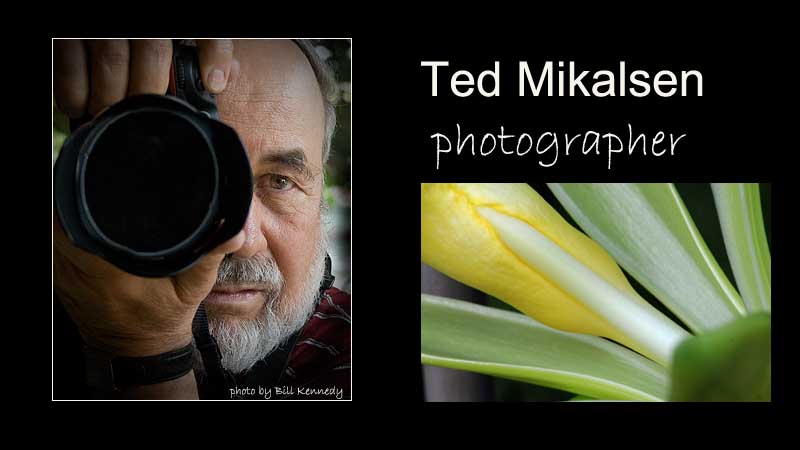
Photography is not about cameras, gadgets or gismos. Photography is about photographers. A camera didn't make a great picture anymore than a typewriter wrote a great novel. - Peter Adams
The camera is an instrument that teaches people how to see without a camera. - Dorothea Lang
Thirty years ago Ted Mikalsen surprised me. We were, the two of us, beginners in photography, and my photos looked like those of a beginner, nothing like those I admired in National Geographic. Then I saw one of Ted’s first efforts and instantly recognized it as art. Ted has gotten much better since then. I have improved too, yet our pursuit of photography has been on entirely different paths.
We met in 1982 when Ted became employed at the Georgia Environmental Protection Division where I’d already been working awhile. We soon discovered that we shared an interest in photography, something neither of us really knew anything about. So we both signed up for photography classes. For these classes we had assignments, photos we made and brought back to class each week. These assignments were meant to teach us to use our manual camera settings properly and, during breaks from work, Ted and I would discuss shutter speeds and f-stops, film speed and different kinds of light. In the classes, I’d been hanging on the teacher’s every word and attempted to use this information to make better photos than I’d done before. “Almost any ordinary subject will do,” said the instructor. “You can make a photo of everyday objects into something remarkable if you put your mind and your camera to work on it.” Thinking of Andy Warhol’s soup cans, I photographed a fire hydrant, imagining that with my new skills I could bring sublime beauty to the mundane. Yet an entire roll devoted to this subject revealed nothing more than thirty-six different well-focused snapshots of an ordinary-looking fire hydrant.
Meanwhile, Ted began returning from his lunch hour with a sandwich in hand, saying he had been too busy walking around downtown Atlanta “digging the urban scene” for a proper lunch. He never let on that he was digging the urban scene with his camera until he entered one of his lunch-time photos in a large juried show and it took third place. Third place! I asked to see the prize-winning photograph and was shown a black and white image of a subway train passing through a MARTA station in Atlanta. Due to the camera’s movement to keep pace with the moving train, much of the surrounding scenery was blurred. Peering from one of the subway car windows was a face, whether male or female could not be discerned, but the face of that commuter in that context conveyed a desperation, a capitulation to the rush of the commuting life that startled me. I couldn’t get that person’s face out of my mind. I did not know, could not know, how Ted captured that feeling. He has told me that he himself did not know then how he did it. Yet, that photograph, he says, was a beginning. This was, I think, a beginning that marks the lives of all artists in which they learn in various degrees to coax an elusive unconscious knowing into the light of conscious intention. Still, he cannot say how. And isn’t that the way of it? Those who can do something remarkable often cannot say how they do it.
What I came to understand was that Ted, then and now, lives in a world of aesthetic sensibility of his own and he has continued to thrive there for years. He stems from a long blood line of artistic mastery going back to a time when members of his family worked in marble for the Medici in Florence and worked later in France where they designed gardens and fountains at Versailles and later in Central Park in New York where a fountain designed by his grandfather stands today.
In the years since the subway photograph, Ted has been prolific. His photographs have had public exposure in many places: as backdrops for dance performances at Atlanta’s Seven Stages Theater, at juried shows including the Second Annual Atlanta Photography Show, at the Georgia State Fair, as well as at the Ceres Gallery in New York City. He’s had one-person shows at the Gallery of the Atlanta-Fulton County Public Library, at Urban Nirvana, at City Gallery East in Atlanta, at the Georgia Botanical Gardens (two shows) and at the Atlanta Botanical Gardens.
I leapt from the photo classes I took with Ted directly into wedding photography. My first wedding “shoot” went well and so I took on another. I still remember taking command of the wedding party, telling the bride and groom, the best man, the maid of honor and the family such important things as where to stand and how they should turn their bodies slightly away but with their faces to the camera. I explained expertly what sort of photos would work best for them and which ones would not. It seemed that I knew what I was doing and that I did it well. It was a shame that every single photo came back from the processor completely and identically black, as if I’d taken two hundred pictures inside the far reaches of a cave. To this day I do not know how that happened. I photographed several more weddings without a hitch, but it was never as much fun after that “all black” episode. I eventually found an enduring fascination with making photographs of many kinds of subjects, but since those wedding photography days I’ve never tried to make money in photography or please anyone but myself with my photos. I learned from experience that I did not enjoy having my photography appraised by a client, publisher or judge.
Ted did the opposite. And his spunk was not only in the face of judges, critics and publishers. His interest in streets, street people, the “urban scene,” took him into the intimidating world of graffiti art. This began unexpectedly, by accident. One day as he prowled the urban landscape with his camera, he rounded a corner of crumbling bricks, headed into an alley, and there it was. He’d stumbled onto an astonishing riot of color and abstraction rivaling that found in an art museum and all done with paint sprayed onto a brick wall. He soon found another wall panel of art or “piece” (as the graffiti “writers” call it–short for masterpiece). Then he found another and another. He discovered that these pieces could most often be found in fairly secluded places where the writers could work without being discovered by the police or property owners.
They probably wouldn’t want to be discovered by a photographer either, but one day Ted, carrying camera and tripod, bumped into a guy carrying a knapsack full of paint cans and other tools of the graffiti artist. The particulars of this meeting have been forgotten by Ted, but it is safe to say that there must have been a moment of awkwardness as Ted introduced himself as Ted Mikalsen to the man who responded that he was known as Raze. Yet Ted somehow managed to present himself as a photographer fascinated with the art, not as one come to document Raze’s vandalism. They talked at length and it turned out that the guy liked what Ted was doing. He told Ted that writers conceal their identities by signing their art with “tags,” not real names and that, in fact, Raze was his tag. From Raze, Ted soon learned of the intricacies of this art, painted with spray cans fitted with expensive nozzles that made possible the delicate rendering of shades and lines. Ted learned something of the Graffiti tradition spanning the lives of many generations of writers, of rules determining who gets to paint where and how soon a writer may expect to have his work written over if it doesn’t earn respect and how soon it gets written over even if it is respected. He learned that graffiti can also be communication–a taunt to a rival or simply statements of ideas via extraordinary images of people and pop culture icons. Either way, the message is usually in cryptic symbolism or spelled out in overlapping and interlocking letters that confound comprehension by the uninitiated. So he found that graffiti exists not only as art, expressing whatever the writer wants–sometimes joy, sometimes angst. To outsiders it may be an expression of “I am here. I am an unseen and powerful artist and I am here among you.”
Many writers are known on the streets, at least by their tags, by other writers, and Raze knew many of them. This made him an indispensable part of what Ted did next, which was to approach the director of City Gallery East, a City of Atlanta-owned and operated gallery that is no longer in existence. With a straight and earnest face he proposed a showing of his graffiti photographs at the gallery. The gallery director was intrigued by the possibilities, seeing as he did that this art form represented an urban sub-culture. After some deliberation he agreed, but in order to fill up the large gallery space, he requested the inclusion of original art by graffiti artists themselves. The trouble was that Ted did not know any of those people but Raze. Also, given the contempt in which they were held by property owners and police, the graffiti artists certainly weren’t going to appear at City Hall. As it turned out, Raze got behind the project, contacting ten writers who agreed to participate. Then Raze and Ted delivered 8 x 16-foot plywood panels to these artists where they could work anonymously. Later, the painted panels were collected by the two men and included in Ted’s show, “Off the Wall: Urban Wall Art in Atlanta” in the summer of 1995.
“It was a controversial show,” says Ted, and several local newspapers, including Creative Loafing, ran stories with different slants on it. Most people were intrigued by this formal presentation of colorful creativity from the urban underbelly, replete as it was with hip-hop music piped in and the tea and cookies served during the exhibit’s opening. Most visitors had seen graffiti art only fleetingly. To see this much refined graffiti art, you’d have to comb the back streets and alleys of the city–something people usually do not do, yet Ted had done it for them and brought what he found into one place.
Then there were the purists who said it was impossible to peel these images from the street and bring them into the sterile, air-conditioned City Gallery without stripping them of their native power and relevance. I can see that. Ask any scuba diver if seeing a shark up close at the Georgia Aquarium is the same as seeing it through a diving mask. Still, for those not willing to dive into the places where graffiti lives, this was their best chance to see it.
Meanwhile, there was another more serious “inside/outside” debate going on. “The gallery director took a lot of heat from his supervisors,” says Ted. “After all, painting walls with graffiti is punishable by law.” Apparently, the mayor’s office didn’t think celebrating graffiti inside City Hall was consistent with arresting graffiti artists on the city streets outside.
Controversial or not, Ted’s graffiti art photography was successful and was maintained in several other galleries for quite a while. It was a good ending after a lot of work and also some tense moments, as in the following story from his early days photographing graffiti. One afternoon on his way home from work Ted parked his car next to a vacant building in mid-town Atlanta, pulled off his coat and tie and lugged his camera gear down a steep ramp into a dank basement previously used as a parking lot. He looked around and found the place empty– probably because nobody in their right mind would go there but drug-dealers, gang members and the graffiti “writers” who regularly left their work on the walls there.
Ted went to a far corner of the lot, set up his tripod and framed a panel of art in his lens. Soon he heard a thumping sound, distant at first but growing more distinct. Just as he recognized the hip-hop beat, the source of the music, a black Cadillac SUV with dark windows, came down the ramp from the street, tires squealing. Now the rhythmic beat echoed from every wall and, without hesitation, the car shot straight for Ted who thought he heard anger in the music and, given the direction and speed of the truck, that he, Ted, was the person with whom someone was displeased. The car stopped next to Ted and expelled five young thugs, each in low-slung pants, draped in chains and scowling behind shades. These fellows walked toward Ted, saying nothing as the music continued, louder now with the vehicle doors open. Ted, who could find no words, held up a hand in a tentative greeting. But these guys ignored Ted, brushed past him and stood with their backs to the graffiti, facing his camera and blocking the camera’s view of the wall art. They crossed their arms, glaring and then shaking their fists at the camera. Or was it at Ted? Ted did not know. The only thing he could think to do was to leave, to grab his camera and get into his car. Maybe they’d be placated by his retreat. As he reached for his camera, though, the music behind him suddenly stopped and Ted turned to see another man in a pin-striped suit walking toward him from the SUV. The man repeatedly jabbed his finger toward Ted and yelled out to the guys in front of Ted’s camera, “You all just crazy! You can stop that posing for this man! He ain’t the one!” Then to Ted he said, “We’re here to shoot a record album cover in front of this wall. It’ll be their debut album. I guess our photographer is late.”
Ted insists this incident took place early in his time of photographing graffiti and has nothing to do with his decision to turn his photographic attention to flowers, his primary photographic occupation during the past decade.
Some people were surprised by the switch, but Ted says it’s really the same subject–that of form. A flower may be the only thing in the photograph, but for Ted the flower as a whole is not the subject. The subject, the thing the viewer is intended to notice first, is form–the curves, lines, shades and colors within the flower. He says that he designs images. He designs them so that we see first the usually unnoticed form within the flower and don’t notice, if only in that first moment, that we are seeing a flower.
Ted’s most favored subject is the infinite convolution of pattern found in the orchid, and he has spent many hours photographing these and other flowers at the Atlanta Botanical Garden Fuqua Orchid Center. It is there that his large photographic prints were displayed for several weeks in the fall of 2009. His photographs of flowers had already appeared in two shows at the Georgia Botanical Gardens in Athens, but Ted found his greatest inspiration in the Fuqua orchids. “It is a place very hospitable to painters and photographers,” he says. “They don’t mind if you want to set up an easel or a tripod. I can walk about until something catches my eye. Then I photograph the elements of the flower that will constitute my design of the final image.”
Following his Atlanta Botanical Garden show, Ted moved to Florida, and the Fuqua Orchid Center is no longer a convenient place for his photography. I imagine that these days he may be seen with his camera in the gardens, salt marshes and city streets of Jacksonville, finding things that only he can see until he shows them to us. I learned long ago that with a Ted Mikalsen photograph I should always expect a surprise.
E-mail Bill: bkennedy@grapevineartandsoulsalon.com
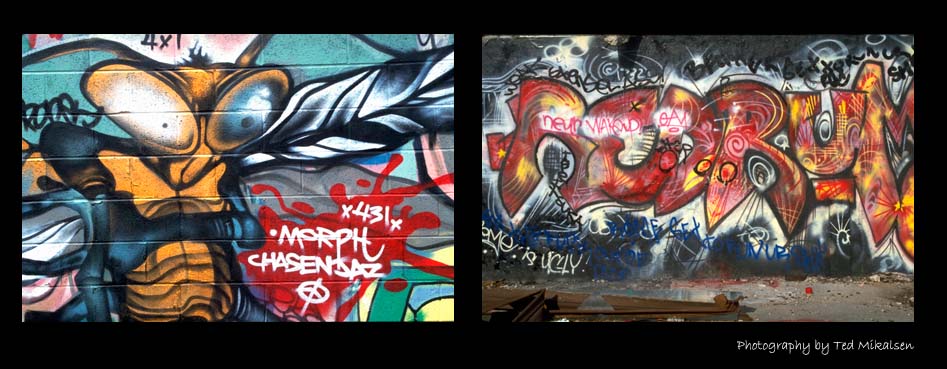
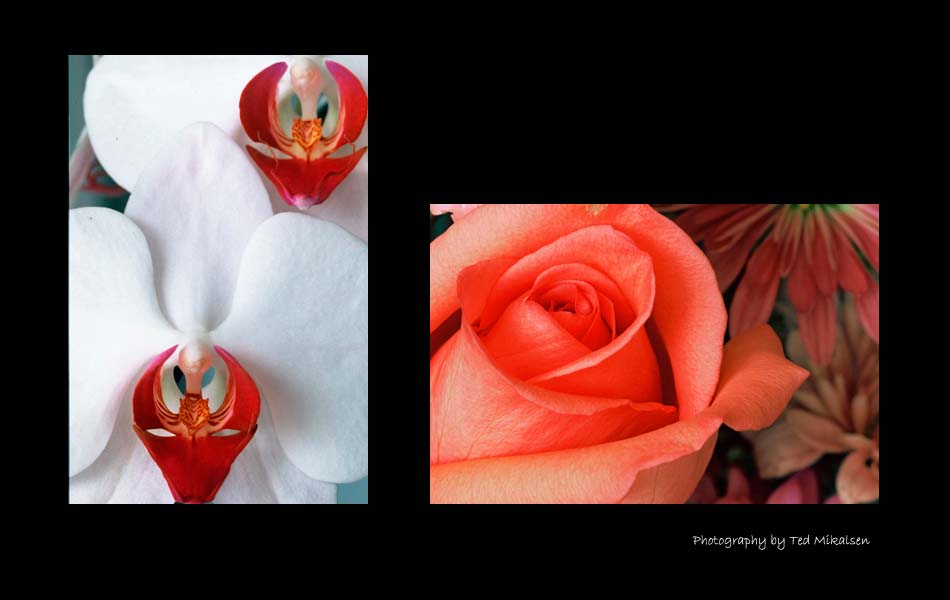
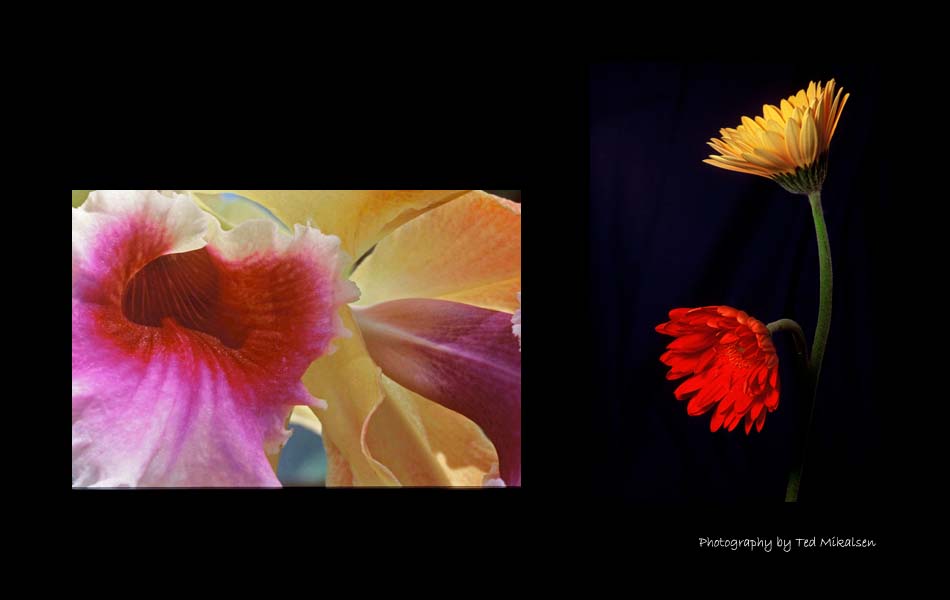
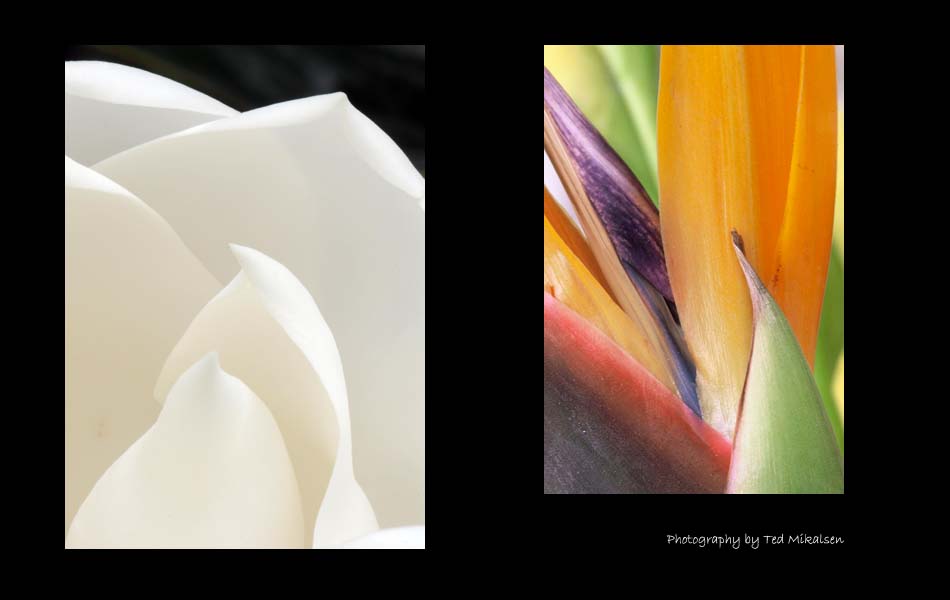
Copyright ©2011 Barbara Knott • All Rights Reserved